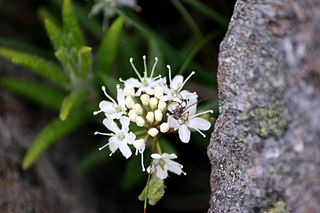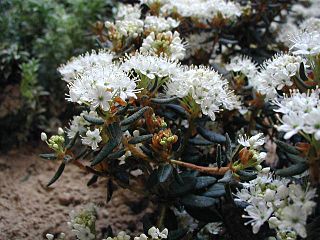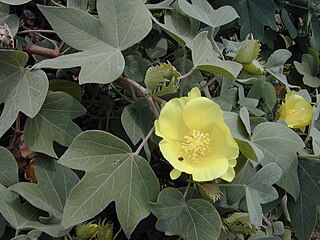
Labrador tea is a common name for three closely related plant species in the genus Rhododendron as well as an herbal tea made from their leaves.

Antidesma is a genus of tropical plant in the family Phyllanthaceae formally described by Linnaeus in 1753. It is native to tropical Africa, S + E + SE Asia, Australia, and various oceanic islands. The greatest diversity occurs in Southeast Asia.

Rhododendron tomentosum, commonly known as marsh Labrador tea, northern Labrador tea or wild rosemary, is a flowering plant in the subsection Ledum of the large genus Rhododendron in the family Ericaceae.

Gossypium tomentosum, commonly known as Maʻo or Hawaiian cotton, is a species of cotton plant that is endemic to the Hawaiian Islands. It inhabits low shrublands at elevations from sea level to 120 m (390 ft). Maʻo is a shrub that reaches a height of 1.5–5 ft (0.46–1.52 m) and a diameter of 5–10 ft (1.5–3.0 m). The seed hairs (lint) are short and reddish brown, unsuitable for spinning or twisting into thread.
Antidesma pyrifolium is a species of plant in the family Phyllanthaceae. It is endemic to Sri Lanka.

Picramnia, the bitterbushes, is a genus of plant considered to be in the family Picramniaceae, but sometimes placed in Simaroubaceae. The name is conserved against the genera Pseudo-brasiliumAdans., and TaririAubl., both which have been rejected.

Antidesma bunius is a species of fruit tree in the family Phyllanthaceae. It is native to Southeast Asia and northern Australia. Its common Philippine name and other names include bignay, bugnay or bignai, Chinese-laurel, Queensland-cherry, salamander-tree, wild cherry, and currant tree.

Eriogonum tomentosum, commonly referred to as dogtongue buckwheat or dogtongue wild buckwheat, is a species in the Polygonaceae family.

Arctium tomentosum, commonly known as the woolly burdock or downy burdock, is a species of burdock belonging to the family Asteraceae. The species was described by Philip Miller in 1768.

Chondrodendron tomentosum is one of six accepted species in the small genus Chondrodendron, belonging to the Moonseed family Menispermaceae. It is a large tropical liana native to Central and South America contains highly toxic alkaloids and is one of the sources of the arrow poison curare - specifically 'tube curare', from the name of which is derived the name of the medicinally valuable alkaloid tubocurarine.

Clerodendrum tomentosum, known as the downy chance, hairy lolly bush, hairy clairy or hairy clerodendrum is a shrub or small tree occurring in eastern and northern Australia. Distributed from Batemans Bay in southern coastal New South Wales, Queensland, Northern Territory, Western Australia, and New Guinea.

Antidesma ghaesembilla is a species of plant in the Phyllanthaceae family. It is native to an area from northern Australia to the Philippines, Zhōngguó/China, and west to India. The shrub or tree usually grows in moist soils in plant communities ranging from savannah to gallery forest to closed forest. It is associated with a number of species of fungus, insects and animals, including emus. Amongst the Mangarrayi and Yangman people of north Australia, the sweet ripe fruit of the tree are much appreciated and linked to the build-up season and to the koel. As well as food, the plant is used as a calendar-plant, for dyeing, in traditional medicine, in religious/magical practices, as fuel, and as an insecticide.
Antidesma alexiteria is a species of plant in the family Phyllanthaceae. It was early classified as a genus within family Euphorbiaceae, but later moved into family Phyllanthaceae. It is endemic to Southern India and Sri Lanka. It is a small understory shrub with maximum height of 8m. Fruits are red in color. In Sri Lanka, the plant is known as "Heen embilla - හීන් ඇඹිල්ල", which is used in Ayurvedic purposes. leaves of A. alexiteria are used as an antidote for many snake bites, and bark of the root for dysentery treatments.
Antidesma puncticulatum, known as mao luang, is a species of plant in the family Phyllanthaceae. It was previously classified as a genus within family Euphorbiaceae, but later moved into family Phyllanthaceae. It is native to South Asia and South-east Asian countries.
Antidesma jayasuriyae, is a species of plant in the family Phyllanthaceae. It is endemic to island of Sri Lanka.

Antidesma japonicum is a shrub in the family Phyllanthaceae. It is found in Southeast Asia, China and Japan. It provides food and fuel. A. japonicum has two accepted varieties: the nominate variety, A. japonicum var. japonicum; and the robustius variety, A. japonicum var. robustius.

Hypericum tomentosum is a species of flowering plant of the St. John's wort family (Hypericaceae) that is found in the western Mediterranean.

Trifolium tomentosum, the woolly clover, is a species of annual herb in the family Fabaceae. They have a self-supporting growth form and compound, broad leaves. Individuals can grow to 8.9 cm.
Homalium tomentosum is a species of flowering plant in the family Salicaceae. It is found in Southeast and South Asia.













